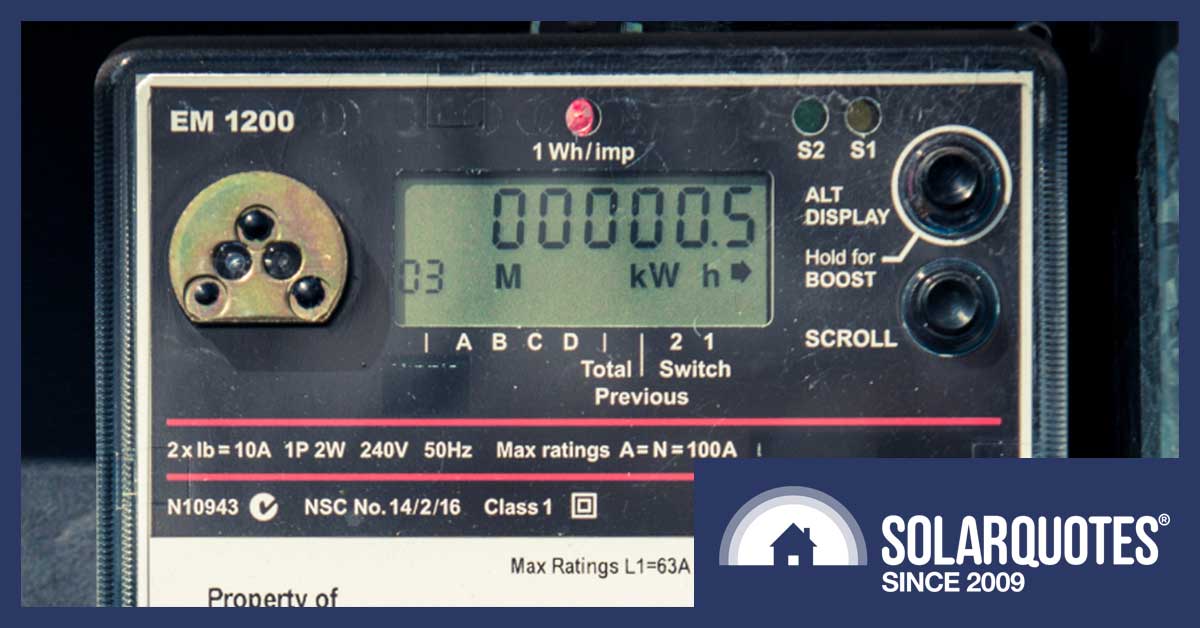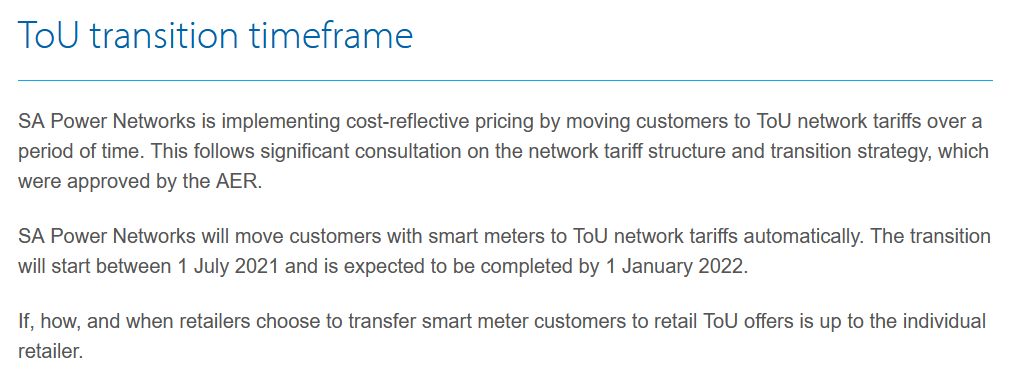
SA homes are not required to have a time-of-use retail electricity tariff when getting solar
Last week I heard from a South Australian concerned they’d be forced onto a time-of-use tariff after installing solar panels.
Since this was at the start of the new financial year, my initial response was, “Oh god! What are the electricity retailers doing now?”
Update July 13th 2021: I have been contacted by the SA Department for Energy and Mining (DEM) and my understanding of what I was told is electricity retailers may soon shift all homes with smart meters — including homes that get solar installed — onto time-of-use tariffs. At the momen — as this article describes — it is possible to find electricity retailers that promise they will allow households to remain on a flat tariff when they have solar installed, but apparently this may change.
Fortunately, retailers are not shaking things up for the new financial year as far as I can tell. The situation has not changed and South Australian households are not being forced onto a time-of-use tariff when they get solar. They can remain on a flat tariff if they wish.
I contacted the three largest electricity retailers in Australia — Origin, AGL, and Energy Australia — and, while Origin hasn’t got back to me yet, both AGL and Energy Australia say they’ll allow SA households to remain on a flat tariff when after installing solar power systems.
This is good news for two reasons:
- Solar households are often better off with a flat tariff than a time-of-use tariff.
- Electricity retailers shouldn’t make life harder for Australian families without good reason.
For a quick rundown of…
- What these tariffs are
- Where some of the confusion comes from, and…
- How to avoid meter change over limbo
…read on.
Flat Tariff Vs. Time-Of-Use
A flat tariff is very simple. A flat amount is charged for each kilowatt-hour of grid electricity consumed regardless of what time of day it’s used. Our Electricity Retailer Comparison page can be used to find flat tariff rates. At the moment in South Australia, some retailers charge less than 30 cents per kilowatt-hour.
Time-of-use tariffs are more complex and require a smart meter. The charge per kilowatt-hour varies according to when the electricity is consumed. For example, in South Australia, there are seasonal tariffs charging more in summer and ones where the charge depends on the time of day.
If you’d like to know details of these plans so you can decide if they’re suitable for you, that’s unfortunate. Neither retailers nor the government Energy Made Easy site clearly present information households require to make an informed decision. If I didn’t have complete faith in the ethical standards of electricity retailers, I’d say it was as if they don’t want people choosing the best plan for themselves.
I might shake the idiot tree later and see if any useful information on SA time-of-use tariff plans falls out, but for now, you’re on your own.
Distributor Tariffs Are Not Retailer Tariffs
Some people think new solar owners will be forced onto a time-of-use tariff because of the tariff the state’s electricity distributor — South Australia Power Networks (SAPN) — charges electricity retailers.

South Australia’s electricity distributor — the Distributed Network Service Supplier — is South Australia Power Networks or SAPN for short.
The distributor tariff covers the cost of taking energy from long-distance transmission lines and rooftops, and using local stobie poles and power lines to get it to homes and businesses. When a household gets solar panels and has a smart meter installed, SAPN automatically changes the flat distribution tariff they were charging the retailer for that property to a time-of-use distribution tariff. But this does not mean the retailer has to charge the household a time-of-use tariff.
SAPN’s tariff is just one component of electricity bills and it is up to retailers to decide what kind of plans they will offer to cover the total amount of money they’re permitted to extract. They can offer a time-of-use tariff but aren’t required to. They are capable of coping with a little variability. It’s like how petrol prices vary daily, but the pizza place doesn’t have to adjust what they charge to deliver each day.
In addition to being free to offer different types of tariffs, if a household gets solar installed and wants to remain on their original flat tariff, then their electricity retailer can ask SAPN to change the distributor tariff back to a flat tariff. Because of this, electricity retailers don’t have a strong incentive to force time-of-use tariffs onto people. Apart from, of course, any pleasure they may derive from making electricity plans more complex.
Electricity Retailers Say SA Homes Can Remain On Flat Tariff
I contacted Australia’s three largest electricity retailers. Both AGL and Energy Australia have told me SA households can stay on a flat tariff when they get solar systems installed if that’s what they want. (Origin sent me an email saying they need to know my suburb or postcode before they can answer my query, which is like me saying I need to know your star sign before I can guess your weight.)
Electricity retailers may push time-of-use tariffs — Energy Australia encouraged me to get one even though I was just asking for information. It is possible your particular retailer won’t offer to let you keep your flat tariff when you get solar panels. If you’re not okay with that, you can tell them you’ll go to a different retailer. If that doesn’t get them to change their tune, dump them. Switching electricity retailers is not difficult to do.
Don’t Get Caught In Meter Changeover Limbo
If you want to remain on a flat tariff, it’s best to check your retailer will allow it without problem as soon as you decide to buy a solar power system. If you change retailers after your solar system is installed but before your old electricity meter is replaced, you can be caught in meter change limbo. It can cause the installation of your new smart meter to be delayed by weeks or even months.
In that time you’ll be unable to use your newly installed solar system because you won’t have the appropriate electricity meter. So I recommend waiting until your solar system is up and running with your new or newly reconfigured meter before defecting.

Not saying electricity retailers need to bend over backwards to please us, but a little flexibility is appreciated.
SA Government Says Time-Of-Tariffs May Be Required
Update July 13th 2021: As I mentioned in the update at the top of the article, the SA Government has informed me all homes with smart meters may be be required to go onto a time-of-use tariff. Hopefully, some retailers will continue to offer plans with flat tariffs to homes with smart meters in the future — but this may not happen.
The South Australian Government’s Department of Energy and Mining has a page on time-of-use tariffs. Here is a screenshot from that page on the transition to time-of-use tariffs:

While the final sentence says it’s up to electricity retailers whether or not they continue to offer time-of-use tariffs, there is unfortunately no guarantee retailers in South Australia will offer flat tariffs to households with smart meters in the future.

 RSS - Posts
RSS - Posts



Ron, as soon as I read this article I asked my wife to ring Origin and ask to be placed back on a flat tariff. (I have a neurological problem similar to Parkinsons which has short circuited the wires between my brain and tongue, so I am unable to carry on a legible conversation) A fairly simple process, right? Wrong!
A case manager is going to ring her back within the next 5 working days, and if they don’t, she has to ring them back.So much for customer service !
We recently moved to Goolwa and had solar installed. They told us that we would need a new meter installed. Which we did. Then we were told by Origin that we had no choice but to go to a time of use tariff.
We will see what happens next week…..
I’m afraid I don’t often hear great things about Origin’s customer service. I suggest telling them you’ll go to AGL or another electricity retailer if they don’t change you to a flat tariff and if they give you any trouble, change retailers.
“Origin’s customer service”…… That sounds a fair bit like “The Zoo’s unicorn”…………..
Well, bugger me, the case manager, just rang and from what I could understand (she had a terrible accent-very difficult to make out what she was saying), it is all SAPN’s fault because they call the shots in SA and what they say goes. So, if they say they we will be on a Tou tariff, then Origin has no choice but to put us on Tou.
When I said rubbish, Agl and Energy Australia didn’t have that problem, she said that we were entitled to go elsewhere.
So Ron, what do you think is the best tarrif for me? I have 6.3kw of panels and a 5kwhr inverter. I am on the age pension and my wife is home looking after me.
Generally you’d be better off on a flat tariff, but some people with solar find they can be better off by limiting their consumption in the evening peak period and shifting consumption to the off-peak period by doing things such as putting their hot water system on a timer. If you let me know the times and charges I may be able to make a better guess.
Time of use might not be a bad thing if you have a battery. I’m presently investigating a TOU plan which has a peak rate (2pm – 8pm) of 39c/kWh, but this is counterbalanced by much lower shoulder and off-peak rates (plus a high feed-in tariff). Looking at my usage over the last few weeks (i.e. winter) shows that I don’t import much from the grid between 2pm and 8pm, because if the solar production isn’t enough to cover consumption, the battery takes over. Naturally, I’d expect it to work even more in my favour during the summer months. (I’m in SA and this TOU plan is not with one of the ‘big three’, by the way.)
We got rooftop PV on our house here in Perth about 5 years ago – and the issue of tariff didn’t arise – we stayed on a flat tariff, and are still there.
Interestingly, our meter had to be changed over – and they provided a new 3-phase unit – but I don’t recall having to pay for it (our house is quite old, so too the old meter – maybe it was overdue to be upgraded anyway).
As of 1st July, our flat tariff has been increased by about 0.5 of a cent/kWh.
We can live with that – but I had thought our increased use of the cheaper wind and rooftop PV here in the West might have DECREASED the rate.
Well – all households did get a $650 COVID credit on their account quite a while back – so we can hardly grumble…
So I live in Northern NSW, we got (forced) switched to TOU when we had solar fitted last October when the smart meter went in. I read I could switch by nagging the distributor (would be easier to nag the retailer). Anyway I deliberately left it as an experiment.
Seeing this prompted me to see if I should end the experiment.
So I thought I’d crunch the numbers, but first I had to find them. Does AGL make it easy yes but NO, which told me straight away I’ll probably be better off with a flat tariff else they’d make it easy to compare and sing from the solar roof tops.
The process AKA bad customer experience (AGL if you’re reading – sack your UX person)
1) go to AGL.com.au
2) click MyAccount it’s called
3) enter email
4) click remember me
5) click next
6) enter password
7) click login
Ok we’re finally in, um no wow factor – ‘look how much we’re saving by being on TOU tariff’
8) Oh look ‘view usage’ let’s click that
9) Ok, so now we can see cost vs solar income and how that compares over time, but where is the TOU breakdown? where is the ‘you could do better by using less during these times?’ why no focus on it?
10) ok, lets click a bar on the graph
11) scroll down (in my case), now we can see some TOU numbers, but for the day only. I need to check my bill for specifics…. no link to bill… just a link to a help site (thanks but no thanks)
12) time to hunt for the bill… click billing
13) hunt around – ahh! click ‘download your bill’
14) ok we have a bill!! nothing useful on the first page, scroll down to next
15) ok lots of numbers with no useful context, look down more and we finally get to the breakdown
16) Now the magic calc, tally up the total units used across the time periods, multiple by the flat rate, is it less or more that the TOU total cost – surprise surprise – it’s flat rate is about 4.5% less.
That wasn’t hard – much….
But now I know, I can go straight to the bill (the ‘yes bit to making it easy) and ignore all the, no doubt very expensive, fancy dashboards that tell us nothing about a real way to save us money by changing none of our usage profile.
I believe that in SA there is a “solar sponge” rate available on the TOU tariff which makes consumption in the middle of the day quite cheap. If you can arrange to use power during this time, eg heat pumps, then combined with solar it would seem to be a good way to cover the lack of self generation on cloudy days.
Thanks for this article ron. There was much confusion around this for me where the sting was coming from. I think the energy retailer was blaming SA power network for charging tou distribution rates but actually it was on them whether they offered TOU or single use tarrif to the consumer. After numerous calls expressing my displeasure and confusion i finally got put onto the accounts team and was told I would be by default put on a tou rate when smart meter was installed but i could call them and make a request with the case management team to change it to flat rate. I agree, if a retailer gives you grief about TOU threaten to go elsewhere!
I just wonder what is that fuss about ToU. It is cheaper with panels. I am in Syd and use ToU here. With nothing special such as aircon I use 600kWh monthly, 350kWh from panels and buy rest which is 250kWh. Winter months (Jun-Aug) I buy around 80kWh peak and only these months. My night tariff is 14.5c while I export at 16c. I have no reason to focus on sunlight as I can buy more at night then save on daylight. Why would I pay 2x for night and 1.5x for shoulder if I buy very few kWh peak?
I was offered (better say attempted to force) to move onto flat. Same retailer, similar plan. They wanted to discontinue my old plan. It was before I had panels. I put it to excel – while paying around $250pm on ToU same usage attracted $50-100 for what I was offered on flat. I believe I was the only one refusing this transition, however.
TOU periods and tariffs vary wildly across the country. Whether a TOU or flat rate plan is better depends a lot on where you are located and the individual household consumption and production patterns.
I believe one is given – peak time is never at night, is it? So when you panels are supplying your electricity how does it matter what peak time price is?
Hi darek peak time is 6-10am and 3pm – 1am in South Australia.
Not necessarily. I’m in SA and my peak time is 2pm – 8pm. I think it must depend on which retailer you’re with and what plan you select.
So, Derek – do you think you can boil a kettle solely with power from your solar panels at 8pm? 6pm maybe? Cook dinner? Do the same at breakfast peak time?
Or, will almost ALL your power for this be imported from the grid, at the more expensive peak TOU tariff?
I would like to understand how your TOU tariff is able to compete with a flat tariff, as with our use profile and tariff options, TOU is not in the hunt.
Let’s shed more light on how ToU is cheaper here.
First cost:
– Peak 54.58
– Shoulder 23.88
– Off 14.13
– FiT 16.0
– Flat is just below 30c, don’t remember exactly
Times:
– Off 2200-0700
– Peak summer 1400-2000
– Peak winter 1700-2100
– No peak April, May, September, October
So, as you see I still schedule washing at night or electric drying. It is cheaper to buy it at night and sell daylight. Summer peak (I mean light peak) I have flat 10kW output from panels for 5h daily (1000-1500) so no load exceeds, I can run aircon and oven and kettle in parallel at 16c FiT. From March I get short afternoon buying around 500Wh daily at 55c. Winter I am short whole peak buying 3kWh daily at 55c. That’s it.
For time when I operate at limited light and below 10kW I deployed automation which queues load. It pauses dishwasher heating if it overlaps with washing machine heating, stops aircon when over limit and starts when too warm and there is surplus. It also pre-heat house 0500-0700 at 14.5c in winter if weather forecasts says is worth it. Now working on signaling DRED to my aircon to throttle in summer when clouds come.
I put number of occasions in excel and recalculated my usage with flat, it is always 20-30% more, maybe except winter.
Here is my pvoutput, I’ll enable full visibility, compare yourself:
https://pvoutput.org/list.jsp?id=88772&sid=78673
BTW – comparing tariffs in pvoutput says the same as my excel do. I can change to flat, just it is only once per year so no way to do it for winter only when it could be little beneficial.
Hm-mm, interesting Derek – it’s quite apparent the benefits vary with circumstances. You obviously have a large system, a surfeit of DRED-type controls, and an excellent tariff structure. I had a look at your generation stats link – it is apparent your generation is about twice that of mine – for interest, we have a 5kW inverter (the largest allowed here in Perth – even though it is 3-phase), and 6.24kW (nominal) of panels (wish I had got the maximum of 6.66 kW, but hadn’t realised this 5 years ago). I suspect your demand far exceeds our rather modest usage, as well.
For interest – what is you panel total plate rating? 10 kW + 30% = 13 kW?
What is your total system cost payback period likely to be (I think ours has nearly paid for itself, over just short of 5 years).
So – our ‘SMART HOME PLAN’ is like this:
– Peak 55.7734 (weekdays only, 3pm to 9pm)
– Weekday shoulder 29.21 (7am to 3pm)
– Weekend shoulder 29.21 (7am to 9pm)
– Everyday off-peak 15.3645 (9pm to 7am)
– FiT 7.135 (or ~ 3 c/kWh for new installs)
– FLAT 26.2026
(all except FiT plus GST)
As you can see, we could save about 11 c/kWh between 9pm and 7am – but our usage is very little in this time-frame, so the savings would be absolutely ‘crunched’ by our after dark peak use. Plus, our FiT nowhere near balances our off-peak rate – so night-time demand shifting doesn’t work for us.
I think you’ve got a great deal…!
Ian,
You right, it depends on deal. I believe peak price is not what kills it, key part is to have FiT >= off-peak and shoulder < flat.
My system is 36*370W in panels and single inverter with 3 strings.
This is misinformation. I’m confident that no retailer in SA will allow you to remain on a flat tariff once the network compulsorily moves you onto ToU tariffs as a result of installing a smart meter/solar.
This is a good thing. People with solar SHOULD have to be on a ToU tariff because it encourages efficient investment decisions: particularly correct orientation matched to load, not oversizing excessively, and considering storage.
Rob, I wouldn’t be that confident if I were you. I’ve recently had solar and a smart meter installed (in Adelaide), and AGL informed me I would be moving to a slightly different flat rate tariff from the one I was on originally. As the rates of the new tariff were slightly worse I decided to shop around, and have gone with a different retailer who offers more innovative plans, as well as energy trading.
Hi Les,
Are you able to suggest which retailer you ended up moving to? I’m keen to leave AGL behind after being with them for the last three months.
Being a solar system owner since 2017, I moved to AGL recently and they have just forced me to a TOU tariff mid contract. Having solar means I now only consume power from the grid during peak times and that has resulted in a 25% increase in my real tariff. They acknowledge this and don’t care.
The ombudsman suggested that most retailers including AGL and Origin are in the process of moving all type 4 smart meter owners over to TOU with no option to go back. Time will tell if this information is good but it appears to be from my experience.
If there is a decent option then I’d be interested to hear about it.
Paul, I went with Discover Energy. As I have a battery, I’m on their VPP (Virtual Power Plant) plan which is TOU based. However the peak time is 2pm-8pm, which means I would only use grid power during this time very rarely.
Discover also have solar plans for non-battery systems but as the rates and times are different from the VPP plan, you should check these out for yourself.
I got my first bill from Discover a little while ago, covering the period from 28 July to 21 August (25 days). Whereas with AGL (pre-solar) I would have expected to pay around $200 for 25 days (we have an all-electric home), with Discover I paid $32. And hopefully I’ll pay even less as summer rolls on, bringing more sunshine. Solar works!